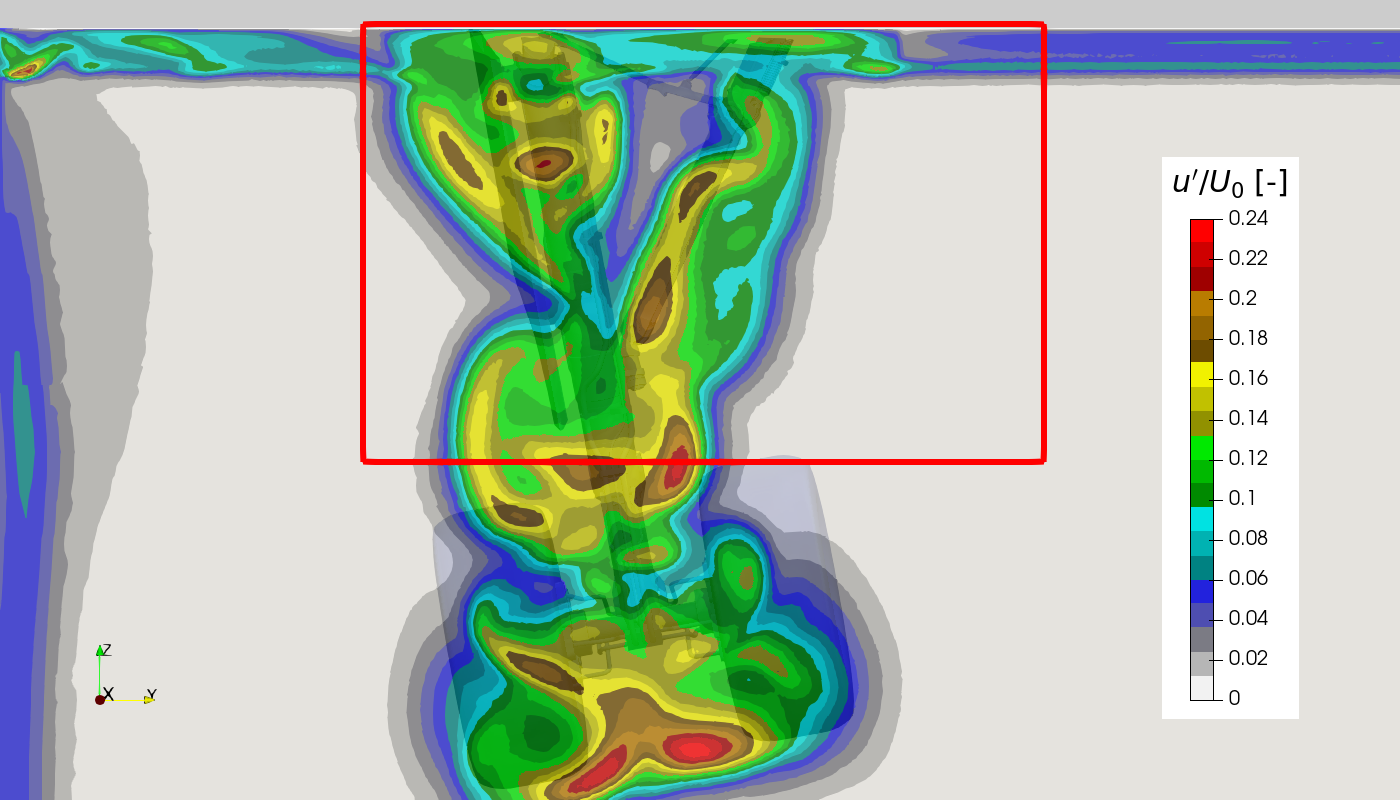Mitigation of landing gear wake / flap interaction noise
High-lift devices and other installed components such as landing gears are known to contribute to the overall noise levels of commercial airplanes during take-off and landing. In recent years, the focus has shifted from investigating and optimising the sound pressure levels emitted from isolated components (e.g. isolated landing gear or the slat) towards studying the interactional effects from the integrated environment of the high-lift wing system [1]. In WP 3.3 of the EU project INVENTOR, two collaborative numerical studies have been conducted by Upstream CFD and DLR-Braunschweig to investigate the noise generated by the interaction of the landing gear wake and the deployed flap.
Upstream CFD conducted both steady-state RANS and scale-resolving simulations (SRS) [2] for a configuration incorporating the nozzle and end plates of the experimental test rig. The landing gear model represents an Airbus A320-type main landing gear configuration at 1:11 scale. The flow topology of the landing gear wake was investigated in more detail to ensure that the CFD delivers an accurate representation of the turbulence impinging on the flap’s leading edge. This was validated by comparing the CFD results with hotwire data measured in the DLR’s AWB wind tunnel. Aeroacoustics results for two configurations with different flap settings were compared, from which a strong interactional noise effect of up to 5 dB could be established.

 Experiment @ DLR |  Simulation (RANS) |  Simulation (SRS) |
Overview of the numerical investigation by Upstream CFD: Instantaneous iso-surfaces of the Q-criterion coloured by Mach number for SRS of configuration with larger flap deflection angle (top); comparison of streamwise velocity fluctuations between simulations and experimental hotwire data (bottom).
In the numerical study of DLR, CAA simulations were conducted using a stochastic forcing approach [3]. The input mean flow field was derived from the RANS solution generated by Upstream CFD, where the generated stochastic fluctuations were confined to the wake region around the flap leading edge and the nozzle / end plates were not incorporated into the numerical setup. The main goal was to evaluate the noise mitigation effect of different porous inserts for the flap leading edge, which were modelled in the simulations via source terms based on Darcy-Forchheimer [4]. For the three porous inserts evaluated, a noise level reduction of up to 5 dB relative to the solid case without insert could be demonstrated.
 |  |
Overview of numerical investigation by DLR: Instantaneous pressure fluctuations on span-normal slice for CAA simulation with PA200 porous insert (left), comparison of OASPL directivies between solid case and cases with different porous inserts (right).
[1] M. Pott-Pollenske, D. Almoneit, G. Saueressig (2017). A Study on Landing Gear Wake - Flap Interaction Noise. Proceedings of the 23rd AIAA/CEAS Aeroacoustics Conference. doi:10.2514/6.2017-3692
[2] M. Fuchs, C. Mockett, J. Sesterhenn, F. Thiele (2019). The grey-area enhanced sigma-DDES approach: Formulation review and application to complex test cases. In: Progress in Hybrid RANS-LES Modelling, Notes on Numerical Fluid Mechanics and Multidisciplinary Design, no. 143, pp. 119-130, Springer, 2019.
[3] S. Proskurov, R. Ewert (2023). Reformulated Flow-Acoustics Splitting for RANS/CAA based Acoustic Metrics: Tip Leakage Flow Problem. AIAA 2023-3500. AIAA AVIATION 2023 Forum. June 2023.
[4] L. Rossian, B.W. Fassmann, R. Ewert, J. Delfs (2016). Prediction of porous trailing edge noise reduction using acoustic jump-conditions at porous interfaces. AIAA 2016-2920. 22nd AIAA/CEAS Aeroacoustics Conference. May 2016.
 |  |
